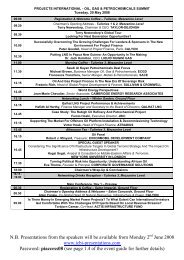Disclosures
Disclosures
Disclosures
Create successful ePaper yourself
Turn your PDF publications into a flip-book with our unique Google optimized e-Paper software.
<strong>Disclosures</strong><br />
Research support: Daiichi, Wyeth, Theravance,<br />
Merck, CIHR, NIH,<br />
Employee: N/A<br />
Consultant: BiondVax, Atox-Bio, Astellas, Bayer,<br />
Merck, Theravance<br />
Major Stockholder: N/A<br />
Scientific Advisory Board: Pfizer-Wyeth, Merck-<br />
Schering, Bayer, Astellas, Theravance, BiondVax,<br />
Atox-Bio, Coronis-Partners<br />
Speakers’ Bureau: Pfizer-Wyeth, Astellas, Cubist.
Motto of the presentation<br />
Because of the need to initiate appropriate<br />
treatment early prior to the causative<br />
pathogen(s) being known, empiric antibiotic<br />
therapy that will cover all likely pathogens is<br />
recommended<br />
American Thoracic Society, Infectious Diseases<br />
Society of America. Guidelines for the<br />
management of adults with hospital-acquired,<br />
ventilator-associated, and healthcare-associated<br />
pneumonia.<br />
Am J Respir Crit Care Med. 2005;171:388-416.
Facts about nosocomial pneumonia (NP)<br />
• NP is the 2nd most common nosocomial infection<br />
and the leading cause of mortality in the<br />
ICU. Flanders SA, Am J Infect Control. 2006;34:84-<br />
93<br />
• NP occurs at a rate of 5 to 10 cases /1000 hospital<br />
admissions, with the incidence increasing by 20-fold<br />
in mechanically ventilated patients (=VAP)<br />
• NP increases hospital stay by 7 to 10 days<br />
• NP produces an excess cost of more than $40,000<br />
per patient.<br />
• NP is responsible for more than 50% of all antibiotics<br />
prescribed in the ICU<br />
•<br />
ATS and IDSA. Guidelines for the management of adults with hospitalacquired,<br />
ventilator-associated, and healthcare-associated pneumonia.<br />
Am J Respir Crit Care Med. 2005 ;171:388-416
Facts about nosocomial pneumonia (NP)<br />
• Mortality rates in NP vary depending on the patient<br />
population, with HAP mortality as high as 30% to 60%,<br />
lower in clinical drug trials 18-25%, higher in<br />
epidemiological trials<br />
• Mortality in VAP varies from 24% to 60%, with the higher<br />
mortality rates occurring when VAP is accompanied by<br />
acute lung injury (ALI) or adult respiratory distress<br />
syndrome (ARDS).<br />
• The majority of deaths that occur during or after an episode<br />
of NP are commonly related to the underlying medical<br />
conditions rather than being directly attributable to NP<br />
Leroy et al. Treat Respir Med. 2004;3:123-31.<br />
Edis EC, et-al. Respiration. 2009;78:416-422.<br />
Connelly SM, et-al. Am J Infect Control. 2009;37:143-9.)<br />
Fagon J,et-al . Am J Respir Crit Care Med. 2000 ;161(3 Pt 1):753-62.<br />
Fagon JY & Chastre J.. Eur Respir J Suppl. 2003 Aug;42:77s-83s.<br />
Markowicz P, et-al.. ARDS Study Group. Am J Respir Crit Care Med. 2000 161:1942-8.
Facts about staphylococcal NP<br />
• The proportion of staphylococcal infections that<br />
were MRSA in U.S. ICUs was 2% in 1974 22% in<br />
1995, and 64% in 2004. Klevens RM,et-al. Clin Infect Dis. 2006<br />
;42:389-91<br />
• Institutional infection control measures used over<br />
a 15-year period (1993 to 2008) have effectively<br />
reduced the overall MRSA infection rate in 38<br />
French hospitals from 41.0% to 26.6%. rate in 38<br />
French hospitals MRSA still remains a major<br />
pathogen. Jarlier V, et al. Arch Intern Med. 2010 ;170:552-9<br />
• Nosocomial Infection Control Consortium (INICC)<br />
reported resistance rates from 2003 to 2008,<br />
showing that MRSA was responsible for 84.1% of<br />
.<br />
hospital associated infections in international ICUs<br />
Rosenthal VD, et-al. Am J Infect Control. 2010;38:95-104.
Facts about MRSA NP<br />
• Patients with VAP due to MRSA had a longer<br />
stay in the ICU than those with (MSSA),<br />
regardless of appropriate initial antibiotic therapy<br />
(Shorr AF, et-al.Crit Care. 2006;10:R97)<br />
• The risk of death in patients with nosocomial<br />
pneumonia due to S.aureus was increased 2.6-<br />
fold (95% [CI], 1.7 to 4.0) when the pathogen<br />
was MRSA .( Gastemeier P et al. Infection. 2005;33:50-5.)
MRSA prolongs ICU stay in VAP,<br />
despite initially appropriate Abx Rx<br />
Shorr AF, et al.<br />
Crit Care Med. 2006;34:700.
Facts about Gram (-) NP<br />
• Ps.aeruginosa is the most common organism<br />
24%, associated with a mortality of ~50%<br />
• Other emerging organisms resistant to Rx<br />
include: Acinetobacter spp. KPC, NDM-1, VIM’s,<br />
AMP-C Enterobacter, Klebsiella, E.coli etc’ ,<br />
Stenotrophomonas sp.<br />
• Therapy options for these organisms:<br />
carbapenems (include. doripenem), colistinpolymyxin,<br />
amikacin, intra-tracheal amikacin,<br />
colistin,levofloxacin and aztreonam
Emergency department<br />
radiograph
MRSA susceptibility<br />
• Oxacillin<br />
• Fluoroquinolone<br />
• Erythromycin<br />
• Vancomycin<br />
• Linezolid<br />
• Clindamycin<br />
• Cephalosporins<br />
• Trimethoprim–<br />
sulphamethoxazole<br />
Resistant<br />
Intermediate<br />
Resistant<br />
Sensitive<br />
Sensitive<br />
Sensitive<br />
Resistant<br />
Sensitive
STAPHYLOCOCCAL<br />
PNEUMONIA (SP)<br />
• Post flu – classically described post-world war 1, healthy<br />
young; high mortality pre-antibiotics & complications but<br />
also recently<br />
• Staphylococcal pneumonia- not post flu; young adults,<br />
predisposing risk factors, infections in hospital, high<br />
mortality<br />
• Right sided endocarditis or SSTIs in IVDU leading to SP;<br />
less severe<br />
• Post inhalation/aspiration; less severe<br />
• HAP/VAP
Confluent staphylococcal bronchopneumonia with invasion of vessels in the<br />
lungs, producing a florid vasculitis (arrow). Secondary thrombosis is occluding<br />
the pulmonary vascular system. (Haematoxylin–eosin stain; original<br />
magnification × 100)
Virulence Factors<br />
• PSM (=phenol soluble protein)<br />
• PVL<br />
• δ toxin<br />
• Agr II- less vancomycin susceptible<br />
• Agr III- in CA MRSA strains more<br />
commonly<br />
(Agr operon upregulates secretion of<br />
virulence factors and downregulates<br />
expression of virulence factors on the<br />
bacterial surface)
S.aureus aetiology of CAP:<br />
culture + and hospitalised<br />
?<br />
Author S.aureus (%) MRSA<br />
Kollef et al 2005 25.5% - Large US<br />
outcomes<br />
database<br />
Stralin &<br />
Soderquist 2006<br />
7.3% - Single institution<br />
Marrie . 2001 2.9% - Review of seven<br />
studies<br />
Torres et al 2009<br />
Woodhead 2002<br />
0-11.73%<br />
4.9 %<br />
-<br />
-<br />
Country specific<br />
across Europe<br />
Review of 41<br />
prospective<br />
studies
Hayward et al. Emerg Inf Dis. 2008;14:720
Brazil
MRSA Load in the UK<br />
Male age standaradized<br />
rate of death due to<br />
MRSA<br />
2001 2005<br />
12.5/mio<br />
25/mio than<br />
decreasing in<br />
2008 31%<br />
Female 6.7/Mio 14.5/Mio than<br />
decreasing in<br />
200813%<br />
MRSA change in death<br />
certificates<br />
+39%<br />
http://www.statistics.gov.uk
HAP /VAP
Incidence of Nosocomial pneumonia caused<br />
by S. aureus<br />
50%<br />
45%<br />
40%<br />
35%<br />
30%<br />
25%<br />
20%<br />
15%<br />
10%<br />
5%<br />
0%<br />
2%<br />
50%<br />
1974 1997<br />
Pujol et al. Eur J Clin Microbiol Inf Dis 1998;17:622<br />
Germaud et al. Rev Pneumol. Clin 1999;55:83
France<br />
• 13.1% of 169 French ICU’s (1993-5) 55.7%<br />
MRSA<br />
(Trouillet JL et al.Am J Respir Crit Care Med 1998; 157: 531-9; Chastre et<br />
al. idem 2002;165: 867-903)<br />
• VAP caused by MRSA 11 additional ICU days<br />
stay compared to MSSA (Schorr et al. Crit Care Med 2006;<br />
34: 700-6)<br />
• Universal screening and preventive isolationcost<br />
benefit of $600-700/ patient in 6 ICU’s (Lucet<br />
et al. Arch Intern Med 2003; 163: 181)
USA<br />
• S.aureus in 20% of cases of HAP or 1%<br />
of all hospitalizations, MRSA 10% of HAP<br />
(NNIS data)<br />
• MRSA VAP- adds 4.4 additional days of<br />
MV and 5 additional ICU days (compared<br />
to MSSA) excess cost $7731 (Schorr et al. Crit<br />
Care 2006; 10: R97)
The Vancomycin ‘Creep’
Vancomycin MIC creep<br />
80<br />
70<br />
60<br />
MIC ≤0.5mg/L<br />
MIC=0.75mg/L<br />
MIC=1.0mg/L<br />
MIC>1.0mg/L<br />
Percentage<br />
50<br />
40<br />
30<br />
20<br />
10<br />
0<br />
2001 2002 2003 2004 2005<br />
Year<br />
Steinkraus, White and Friedrich. J Antimicrob Chemother 2007;60:788-794
Vancomycin MIC significantly<br />
predicts mortality in MRSA<br />
Treatment group<br />
Risk of mortality<br />
(OR [95% CI])<br />
P-value<br />
Vancomycin MIC=1 1<br />
Vancomycin MIC=1.5 2.86 (0.87, 9.35) 0.08<br />
Vancomycin MIC=2 6.39 (1.68, 24.3)
Reduced vancomycin efficacy<br />
with higher MIC<br />
Data taken from 30* MRSA bloodstream isolates from US hospitals<br />
100<br />
80<br />
P=0.01<br />
Success, %<br />
60<br />
40<br />
56<br />
20<br />
0<br />
10<br />
n=9 n=21<br />
≤0.5 1.0–2.0<br />
Vancomycin MIC, µg/ml<br />
*23 isolates were vancomycin treatment failures, 7 were treatment successes<br />
Sakoulas G et al. J Clin Microbiol. 2004;42:2398–2402
Therapy
Risk Factors for Multidrug-Resistant<br />
Pathogens Causing HAP or VAP<br />
• ABx Rx in the preceding 90 days<br />
• Current hospital stay > 5 days<br />
• ABX resistance that is highly prevalent in hospital/unit<br />
• Immunosuppressive disease or therapy<br />
• Hospitalization of > 2 days in the last 90 days<br />
• Residence in a nursing home or extended care facility<br />
• Infusion home therapy<br />
• Receipt of long-term dialysis in the last 30 days<br />
• Wound care<br />
• Family member with MDR pathogen<br />
Guidelines for the management of adults with hospital-acquired, ventilator-associated,<br />
and healthcare-associated pneumonia. Am J Respir Crit Care Med. 2005;171:388.
*Mortality refers to crude or infection-related mortality<br />
Alvarez-Lerma F et al. Intensive Care Med 1996;22:387-394.<br />
Ibrahim EH et al. Chest 2000;118L146-155.<br />
Kollef MH et al. Chest 1999; 115:462-474<br />
Kollef MH et al. Chest 1998;113:412-420.<br />
Luna CM et al. Chest 1997;111:676-685.<br />
Rello J et al. Am J Resp Crit Care Med 1997;156:196-200.<br />
Mortality Associated With Initial Inadequate<br />
Therapy In Critically Ill Patients With<br />
Serious Infections in the ICU<br />
Alvarez-Lerma,1996<br />
Rello, 1997<br />
Kollef, 1999<br />
Kollef, 1998<br />
Initial appropriate<br />
therapy<br />
Initial inadequate<br />
therapy<br />
Ibrahim, 2000<br />
Luna, 1997<br />
Mortality*<br />
0% 20% 40% 60% 80% 100%
Mortality Rates Associated With Inadequate, Inappropriate,<br />
Delayed, or Lack of Antibiotic Treatment for NP<br />
Random effects model. Heterogeneity: Cochran’s Q (15 df)=79.04, p
Random Effects Model for Imputed Placebo Eliminating<br />
Three Studies to Reduce Heterogeneity<br />
Heterogeneity: Cochran’s Q (12 df)=8.38, p=0.75<br />
Note: Imputed placebo may be an underestimate since most patients received some treatment.
Mortality Risk with Increasing Delays in<br />
Initiation of Effective Antimicrobial Therapy<br />
Kumar et al, CCM 2006:34:1589-96<br />
Odds Ratio of Death<br />
(95% Confidence Interval)<br />
100<br />
10<br />
1<br />
>36<br />
24-35.99<br />
12-23.99<br />
9-11.99<br />
6-8.99<br />
5-5.99<br />
4-4.99<br />
3-3.99<br />
2-2.99<br />
1-1.99<br />
Time (hrs)
Linezolid vs Comparator(s) in HAP/VAP<br />
Study<br />
Pneumonia<br />
Linezolid<br />
Comparator<br />
Cepeda et al 86 15/18 (83%) 24/29 (72%)<br />
Wilcox et al 88 42/45 (93%) 42/46 (91%)<br />
Kaplan et al 89 9/10 (90%) 10/10 (100%)<br />
Wunderink et al 91 114/168 (68%) 111/171 (65%)<br />
San Pedro et al 92 63/71 (89%) 62/70 (89%)<br />
Stevens et al 93 9/12 (75%) 12/16 (75%)<br />
Rubinstein et al 94 71/107 (66%) 62/91 (68%)<br />
Total 323/431 (74·9%) 323/433 (74·6%)
Linezolid vs vancomycin for Gram-positive<br />
nosocomial pneumonia: clinical cure rates<br />
Linezolid<br />
Vancomycin<br />
80<br />
P=0.182<br />
P=0.009<br />
Clinical cure, %<br />
60<br />
40<br />
20<br />
51.5<br />
43.4<br />
59.0<br />
35.5<br />
0<br />
S. aureus (n=272) MRSA* (n=123)<br />
Wunderink R et al. Chest 2003;124:1789–1797<br />
Type of pneumonia<br />
Data from patients with indeterminate or missing clinical outcomes were excluded<br />
*A subset of patients with S. aureus pneumonia
Wunderink RG, et al. Chest. 2008;134:1200
Wunderink RG, et al. Chest. 2008;134:1200
Vanco(popotamus)<br />
Large molecule<br />
Penetrates slowly<br />
Slowly cidal<br />
Difficult to measure
Not such smart therapy<br />
• Vanco in the lung::<br />
• Concentrations in Plasma:ELF=6:1<br />
• 36% of patients ELF vanco conc. < 4 mg/L
Vancomycin therapy for MRSA<br />
VAP<br />
• Patients with MRSA VAP treated with<br />
vancomycin have 50% mortality, patients with<br />
MSSA VAP treated with vancomycin have a<br />
47% mortality<br />
(Gonzalez et al. Clin Inf Dis 1999;29:1171-7)<br />
• Patients with MSSA VAP treated with betalactam<br />
have a mortality of ~5%<br />
(Rello et al. A J R C C M 1994;150:1545).
RECENT STUDIES IN HAP/VAP<br />
Tigecycline – Effective in HAP but not VAP<br />
Ceftobiprole – Effective in HAP but not VAP<br />
(Rejected by the FDA)<br />
Doripenem – Effective in HAP & VAP<br />
Telavancin – Effective in HAP & VAP<br />
(Rejected by the FDA)<br />
Linezolid inHAP/VAP-Effective
Therapy of S.aureus CAP
Following his admission to the intensive care unit, the patient<br />
was administered cefuroxime and prednisone intravenously
• Patient 1<br />
• Ceftriaxone<br />
15 h after admission<br />
• Addition of<br />
vancomycin<br />
clindamycin<br />
• Patient 2<br />
• Ceftriaxone, amikacin,<br />
and levofloxacin<br />
14 h after admission<br />
• Clindamycin and linezolid<br />
plus Tegeline<br />
J Clin Microbiol. 2010;48:1952-5.
Characteristics of pneumonia<br />
caused by PVL+ S.aureus<br />
• Rare<br />
• Mortality 40% and rapid (within 1-4 d)<br />
• Rapid progression<br />
• Young patients<br />
• Hempthysis 40%<br />
• Leukopenia 40%<br />
10% survival when<br />
WBC
Diep et al. Proc Natl Acad Sci USA (2010) vol. 107 (12) pp.<br />
5587-92<br />
PVL contributes to virulence of USA300<br />
in rabbit model of necrotizing<br />
pneumonia
Clinical features of PVL-associated pneumonia<br />
(1999 – 2010)<br />
Sicot N et al
Similar kinetic of death for MRSA<br />
and MSSA cases<br />
Cumulative probability of<br />
survival<br />
1.0<br />
0.8<br />
0.6<br />
0.4<br />
CA-MRSA pneumonia<br />
CA-MSSA pneumonia<br />
0.2<br />
Days<br />
0.0<br />
0 5 10 15 20 25 30<br />
Sicot N et al (in press)
350%<br />
300%<br />
PVL level reported to control by MSSA<br />
250%<br />
200%<br />
150%<br />
100%<br />
50%<br />
0%<br />
200%<br />
150%<br />
100%<br />
50%<br />
No antibiotic<br />
* * * * *<br />
*<br />
No antibiotic<br />
⅛ MIC<br />
¼ MIC<br />
½ MIC<br />
Oxacillin Clindamycin Linezolid Fusidic acid Rifampicin<br />
*<br />
* * *<br />
*<br />
*<br />
* *<br />
*<br />
0%<br />
No antibiotic<br />
Pristinamycin Tetracycline Ofloxacin Co-trimoxazole Vancomycin
β-lactams which bind PBP1 enhance PVL<br />
production<br />
Level of PVL production<br />
PVL mRNA fold change<br />
No atb OXA IMI CTX CCL FOX<br />
Selective ligand : PBP1-4 PBP1 PBP2 PBP3 PBP4<br />
Dumitrescu et al Antimicrob Agents Chemother 2007;51:1515-9<br />
Dumitrescu et al Clin Microbiol Infect 2008; 14: 384–388
Which antibiotics on MRSA?<br />
Vancomycin<br />
(in vitro)<br />
Linezolid<br />
(in vivo)<br />
Ceftobiprole<br />
(in vivo)<br />
ATCC 33591<br />
Log 10 CFU / Thigh<br />
T>MIC<br />
0 2 4 8 12 18 24<br />
Time (hours)<br />
Linezolid better than vancomycin<br />
But only ceftobiprole kills rapidly MRSA<br />
Palmer SM et al. Antimicrob Agents Chemother 1996;40:701–705<br />
Houlihan HH et al Antimicrob Agents Chemother. 1997;41:2497-501.<br />
Craig WA et al. Antimicrob Agents Chemother. 2008;52:3492-6.
Guidelines for treatment<br />
• Guidelines for CA-MRSA pneumonia only in UK :<br />
• combination of clindamycin 1.2 g iv qds, linezolid 600 mg iv<br />
bd and rifampicin 600 mg bd until the patient has improved<br />
and is clinically stable,<br />
• 1-2g/kg of IVIG, be repeated after 48 h if there is still evidence<br />
of sepsis, or failure to respond<br />
• US Guidelines for MRSA pneumonia :<br />
• American Thoracic Society/Infectious Disease Society of<br />
America: vancomycin trough concentrations of 15–20 mg/mL<br />
and linezolid as alternative choice.
New therapeutic options for<br />
Resistant Gram (-) NP<br />
• Colistin (IT + systemic) ~50-66% efficacy<br />
• Tigecycline and alike<br />
• IT amikacin, aztreonam, ciprofloxacin,<br />
levofloxacin-phase II clinical trials.<br />
• New fluoroquinolones with activity in acidic<br />
pH and with anaerobic activity.<br />
• New vaccines<br />
• Biologic modifiiers
Remaining issues to be discussed<br />
• Place of IT Abx therapy<br />
• Is vanco creep an issue?<br />
• Is renal failure in MRSA patients an<br />
indication for linezolid?<br />
• Is step down therapy important? When?<br />
• How long to treat?<br />
• Single vs. combi?
• The real world utilization of the ‘bundle’<br />
approach in the ICU, is it applicable toall<br />
patients?<br />
• The role of antecedent partially<br />
preventable LRTI (H1N1, H5N1,<br />
pneumococcal pneumonia, COPD, etc’)
Rubinstein et al. A A C 2003;47:1824-31
Liang Beibei, et al. International Journal of Antimicrobial Agents 2010; 35: 3-12.<br />
72








